
World's brightest flashlight
Tesladownunder, Mon Sept 27 2010, 07:35AM84,000 lumens. 'nuf said.
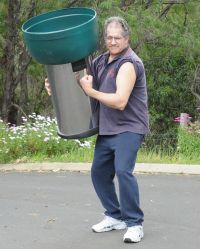
Re: World's brightest flashlight
GhostNull, Mon Sept 27 2010, 09:34AM
That *might* blind someone
GhostNull, Mon Sept 27 2010, 09:34AM
That *might* blind someone
Re: World's brightest flashlight
Tesladownunder, Mon Sept 27 2010, 10:17AM
Baaaaahhh. They probably deserved it!
Seriously. This will have a total light output of 150W (10% efficiency at 1500W input). So like a 150W laser unfocused to whatever beam size so a lot of total output. Sounds dangerous.
However,
A single 10W light output from a single 100W electrical input LED focused at 5 degrees is perhaps 20cm diam (= 0.04 m2) ,at 1m. i.e. 250W/m2. Sunlight is 1000W/m2 of which only 20% is visible. ie 200W/m2. It comes from a 1 degree source.
Hence at 1m, using back of an envelope figures you will see 11 large (5X) weak suns in a circle and a red, green and blue sun in the middle. You will blink and look away reflexively . You will not get an excessive dose as in a laser which will focus to a point and burn in a short time.
It should be fairly safe but still should not be used irresponsibly.
It is bright but not focused in a manner to cause damage.
I am much more concerned about my 40mW Blu-ray laser as an eye risk.
Tesladownunder, Mon Sept 27 2010, 10:17AM
Baaaaahhh. They probably deserved it!
Seriously. This will have a total light output of 150W (10% efficiency at 1500W input). So like a 150W laser unfocused to whatever beam size so a lot of total output. Sounds dangerous.
However,
A single 10W light output from a single 100W electrical input LED focused at 5 degrees is perhaps 20cm diam (= 0.04 m2) ,at 1m. i.e. 250W/m2. Sunlight is 1000W/m2 of which only 20% is visible. ie 200W/m2. It comes from a 1 degree source.
Hence at 1m, using back of an envelope figures you will see 11 large (5X) weak suns in a circle and a red, green and blue sun in the middle. You will blink and look away reflexively . You will not get an excessive dose as in a laser which will focus to a point and burn in a short time.
It should be fairly safe but still should not be used irresponsibly.
It is bright but not focused in a manner to cause damage.
I am much more concerned about my 40mW Blu-ray laser as an eye risk.
Re: World's brightest flashlight
GhostNull, Mon Sept 27 2010, 12:59PM
Ah, okay then. Silly me >.<
Are you going to make a diffuser, reflective backing and that stuff?
GhostNull, Mon Sept 27 2010, 12:59PM
Ah, okay then. Silly me >.<
Are you going to make a diffuser, reflective backing and that stuff?
Re: World's brightest flashlight
Killa-X, Mon Sept 27 2010, 03:06PM
Someone needs to tell wicked lasers that they no longer have "the worlds brightest flashlight" I think you won that!
Does it take giant batteries too? :P large pipe painted black with terminals, to look and act like a giant battery? :D
Killa-X, Mon Sept 27 2010, 03:06PM
Someone needs to tell wicked lasers that they no longer have "the worlds brightest flashlight" I think you won that!
Does it take giant batteries too? :P large pipe painted black with terminals, to look and act like a giant battery? :D
Re: World's brightest flashlight
Tesladownunder, Mon Sept 27 2010, 07:16PM
This project uses the same front end as is on the World's brightest bike light project. Best to read this thread with the other as well.
Batteries are the same 3 deep cycle batts. They will have plenty of room but will need an internal frame as the steel cylinder is quite thin.
The chrome plated "body" of the torch is a rubbish bin/trash can and the green front is the top of a plastic water tank. Each of the fans has the LED on the other side and a 10cm lens.
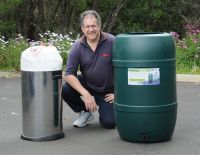

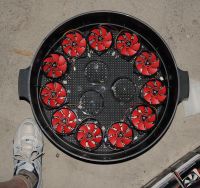

Tesladownunder, Mon Sept 27 2010, 07:16PM
Killa-X wrote ...
Someone needs to tell wicked lasers that they no longer have "the worlds brightest flashlight" I think you won that!
Does it take giant batteries too? :P large pipe painted black with terminals, to look and act like a giant battery? :D
It's easy to make a claim and rather hard to refute, particularly if it has not appeared on the net. Of course, it's not always comparing apples and oranges. Like mine is not commercially useful, theirs is. Mine can't be focussed well, theirs can. Hence theirs will have higher peak intensity at a distance (candlepower) due to better focus. Mine has more total light output (lumens).Someone needs to tell wicked lasers that they no longer have "the worlds brightest flashlight" I think you won that!
Does it take giant batteries too? :P large pipe painted black with terminals, to look and act like a giant battery? :D
This project uses the same front end as is on the World's brightest bike light project. Best to read this thread with the other as well.
Batteries are the same 3 deep cycle batts. They will have plenty of room but will need an internal frame as the steel cylinder is quite thin.
GhostNull wrote ...
Are you going to make a diffuser, reflective backing and that stuff?
Nope. I want as tight a beam as I can ie 5 degrees. It's already hard enough to focus a source nearly 1 inch square. There is no back radiation.Are you going to make a diffuser, reflective backing and that stuff?
The chrome plated "body" of the torch is a rubbish bin/trash can and the green front is the top of a plastic water tank. Each of the fans has the LED on the other side and a 10cm lens.




Re: World's brightest flashlight
ConKbot of Doom, Mon Sept 27 2010, 09:46PM
Are those deal extreme 100W LEDs? They look similar to a lot of the high power arrays I see on there. I'd love to suggest SST-90's or CBT-360's from luminus, but I'm guessing the price point wouldnt be too nice on those.
ConKbot of Doom, Mon Sept 27 2010, 09:46PM
Are those deal extreme 100W LEDs? They look similar to a lot of the high power arrays I see on there. I'd love to suggest SST-90's or CBT-360's from luminus, but I'm guessing the price point wouldnt be too nice on those.
Re: World's brightest flashlight
Tesladownunder, Tue Sept 28 2010, 12:43AM
Here is the eBay store I got theLED's, lenses and fans from.

Tesladownunder, Tue Sept 28 2010, 12:43AM
Here is the eBay store I got theLED's, lenses and fans from.

Re: World's brightest flashlight
Adam Munich, Tue Sept 28 2010, 12:58AM
Wow, $100 a piece. I wish I had cash to blow like you.
Adam Munich, Tue Sept 28 2010, 12:58AM
Wow, $100 a piece. I wish I had cash to blow like you.
Re: World's brightest flashlight
Tesladownunder, Tue Sept 28 2010, 12:05PM
I have just worked at my day job (medical specialist doctor) the last 4 months at 100h per week. (15 hour days, 10h Sundays) How many did you work?
I don't own a car. Do you?
If you are a student, when you graduate and get a job, do you expect to work that much or expect to own a car.
Do the sums. Still wish for that?
I will spend $5000 on this project. The real cost is not that, it's the money I won't earn for the time I spend on the project - probably 5 times that amount.
So the real comment should be, "Why do you lose so much money by not working for that time".
The real answer is "how much is it worth to have the biggest and best in the world and be appreciated for it". Some people just want the best car in their street/suburb/town and pay a vast lot more.
Anyway, I am trying to commercialise the project - hence the video.
Tesladownunder, Tue Sept 28 2010, 12:05PM
Grenadier wrote ...
Wow, $100 a piece. I wish I had cash to blow like you.
Ahh, the politics of envy...Wow, $100 a piece. I wish I had cash to blow like you.
I have just worked at my day job (medical specialist doctor) the last 4 months at 100h per week. (15 hour days, 10h Sundays) How many did you work?
I don't own a car. Do you?
If you are a student, when you graduate and get a job, do you expect to work that much or expect to own a car.
Do the sums. Still wish for that?
I will spend $5000 on this project. The real cost is not that, it's the money I won't earn for the time I spend on the project - probably 5 times that amount.
So the real comment should be, "Why do you lose so much money by not working for that time".
The real answer is "how much is it worth to have the biggest and best in the world and be appreciated for it". Some people just want the best car in their street/suburb/town and pay a vast lot more.
Anyway, I am trying to commercialise the project - hence the video.
Re: World's brightest flashlight
GhostNull, Tue Sept 28 2010, 12:56PM
Nice video! But I don't really like the idea of hobbyists commercialising. It just give me goose bumps. urgh =S
GhostNull, Tue Sept 28 2010, 12:56PM
Nice video! But I don't really like the idea of hobbyists commercialising. It just give me goose bumps. urgh =S
Re: World's brightest flashlight
lpfthings, Tue Sept 28 2010, 01:00PM
Hahaha oh god, I just got my learners license, please don't let me see anyone heading towards me with that on!
Although, it'd make for great conversation :)
How do you intend on powering it?
lpfthings, Tue Sept 28 2010, 01:00PM
Hahaha oh god, I just got my learners license, please don't let me see anyone heading towards me with that on!
Although, it'd make for great conversation :)
How do you intend on powering it?
Re: World's brightest flashlight
teravolt, Tue Sept 28 2010, 07:31PM
nice work have you fired it up yet? Do you plan to have guinnis books of records look at it? You probibly thought about lithium ion. Maby a 4" pvc tube full of them would make a better handel and be lighter for comershal use.
teravolt, Tue Sept 28 2010, 07:31PM
nice work have you fired it up yet? Do you plan to have guinnis books of records look at it? You probibly thought about lithium ion. Maby a 4" pvc tube full of them would make a better handel and be lighter for comershal use.
Re: World's brightest flashlight
Tesladownunder, Tue Sept 28 2010, 07:40PM
Batteries: three 33AH deep cycle batts good for 12.2V 35A dropping to 12.0V at 12 mins. At 70A 11.8V dropping to 11.7A at 6 mins. Need to run 34V at 52 A peak (1.8kW) delivered to LEDs ie need to drop from (12.0 x 3=36) 36V to 34V. 2V drop at 50A is barely enough for heavy duty cabling and some big MOSFET's to do PWM. A lot of care will need to be taken with very low value load equalising resistors. This is all a bit on the edge.
Meters read 55A, 33V and 65 degreesC during a power test

Tesladownunder, Tue Sept 28 2010, 07:40PM
Batteries: three 33AH deep cycle batts good for 12.2V 35A dropping to 12.0V at 12 mins. At 70A 11.8V dropping to 11.7A at 6 mins. Need to run 34V at 52 A peak (1.8kW) delivered to LEDs ie need to drop from (12.0 x 3=36) 36V to 34V. 2V drop at 50A is barely enough for heavy duty cabling and some big MOSFET's to do PWM. A lot of care will need to be taken with very low value load equalising resistors. This is all a bit on the edge.
Meters read 55A, 33V and 65 degreesC during a power test

Re: World's brightest flashlight
Duality, Tue Sept 28 2010, 08:35PM
could it be seen from outer space?
Duality, Tue Sept 28 2010, 08:35PM
could it be seen from outer space?
Re: World's brightest flashlight
Adam Munich, Tue Sept 28 2010, 09:01PM
What do you mean by "Going commercial?" Do you plan on selling these? I'm not too sure anybody will buy a $5000 flashlight, even if it is this size.
Adam Munich, Tue Sept 28 2010, 09:01PM
What do you mean by "Going commercial?" Do you plan on selling these? I'm not too sure anybody will buy a $5000 flashlight, even if it is this size.
Re: World's brightest flashlight
GhostNull, Tue Sept 28 2010, 10:59PM
If you watched the video then you would know

GhostNull, Tue Sept 28 2010, 10:59PM
If you watched the video then you would know


Re: World's brightest flashlight
Adam Munich, Wed Sept 29 2010, 12:44AM
Ahh, I see, it's an I want to be on TV thing. Makes sense now.
Good luck with the project! Also TDU, have you found any more hidden numbers on these LEDs?
I once again suggest a lithium battery, as they are much lighter and much smaller. That's key in a flashlight, especially of this size. One more note, you may have to get the Australian equivalent of FAA clearance to shine this thing into the air.
Adam Munich, Wed Sept 29 2010, 12:44AM
Ahh, I see, it's an I want to be on TV thing. Makes sense now.
Good luck with the project! Also TDU, have you found any more hidden numbers on these LEDs?
I once again suggest a lithium battery, as they are much lighter and much smaller. That's key in a flashlight, especially of this size. One more note, you may have to get the Australian equivalent of FAA clearance to shine this thing into the air.
Re: World's brightest flashlight
teravolt, Wed Sept 29 2010, 03:01AM
when do you plan to have it operational and are you going to add a sholder strap for ease of transport
teravolt, Wed Sept 29 2010, 03:01AM
when do you plan to have it operational and are you going to add a sholder strap for ease of transport
Re: World's brightest flashlight
Steve Conner, Wed Sept 29 2010, 09:45AM

Peter, PM or e-mail me if you want a hand with the power electronics, in confidence, this project is so crazy that it simply has to succeed
Steve Conner, Wed Sept 29 2010, 09:45AM
Grenadier wrote ...
Ahh, I see, it's an I want to be on TV thing.
An I want to be on TV "Yet Again" thing Ahh, I see, it's an I want to be on TV thing.

Peter, PM or e-mail me if you want a hand with the power electronics, in confidence, this project is so crazy that it simply has to succeed

Re: World's brightest flashlight
Tesladownunder, Wed Sept 29 2010, 11:12AM
Steve, I might take you up on this. Due credit will be given. I will email as it is fastest for me.
Pic below is the setup on the bike. The frontend will be the same as the Worlds brightest bike lights and needs to be detachable.
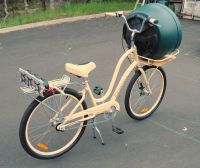
This shows the 1.5 ohm equalising resistors needed for the 3 different colours. Red LEDs need almost 10V less.
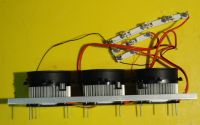
Tesladownunder, Wed Sept 29 2010, 11:12AM
Steve McConner wrote ...
An I want to be on TV "Yet Again" thing
Peter, PM or e-mail me if you want a hand with the power electronics, in confidence, this project is so crazy that it simply has to succeed
Raison d'etre you could say.An I want to be on TV "Yet Again" thing

Peter, PM or e-mail me if you want a hand with the power electronics, in confidence, this project is so crazy that it simply has to succeed

Steve, I might take you up on this. Due credit will be given. I will email as it is fastest for me.
Pic below is the setup on the bike. The frontend will be the same as the Worlds brightest bike lights and needs to be detachable.

This shows the 1.5 ohm equalising resistors needed for the 3 different colours. Red LEDs need almost 10V less.

R v.d. Tuuk wrote ...
could it be seen from outer space?
Space = arbitrary 100 miles. Lets look at the reverse. A satellite can easily be seen against a black sky with dark adapted eyes - particularly the Iridium series. These will reflect light from the sun at 200W visible light per m2 from a 1 degree source. The reflecting surface will be say one square m from the satellite. ..... actually I am having trouble getting my head around the concept. Anyone want to have a go with those parameters?could it be seen from outer space?
Re: World's brightest flashlight
Avi, Wed Sept 29 2010, 04:20PM
Avi, Wed Sept 29 2010, 04:20PM
R v.d. Tuuk wrote ...
could it be seen from outer space?
heaven forbid you point anything above 1mW upwards, in Australia...could it be seen from outer space?
Re: World's brightest flashlight
Killa-X, Thu Sept 30 2010, 02:29AM
Yeah...They got strict rules on lasers, I wonder if they would complain about a beam of light. I've seen videos of arc lights beaming to the sky, looks cool!
Killa-X, Thu Sept 30 2010, 02:29AM
Avi wrote ...
R v.d. Tuuk wrote ...
could it be seen from outer space?
heaven forbid you point anything above 1mW upwards, in Australia...could it be seen from outer space?
Yeah...They got strict rules on lasers, I wonder if they would complain about a beam of light. I've seen videos of arc lights beaming to the sky, looks cool!
Re: World's brightest flashlight
Bored Chemist, Thu Sept 30 2010, 07:47PM
You can make light spots on clouds with a 1KW stage spot light. If you can see the bright spot on the cloud from the earth then I can't see why you couldn't see it from space.
Spotlights are not that efficient (compared to LEDs) and you are running more than 1KW so I think it could be seen from space.
Bored Chemist, Thu Sept 30 2010, 07:47PM
You can make light spots on clouds with a 1KW stage spot light. If you can see the bright spot on the cloud from the earth then I can't see why you couldn't see it from space.
Spotlights are not that efficient (compared to LEDs) and you are running more than 1KW so I think it could be seen from space.
Re: World's brightest flashlight
Adam Munich, Thu Sept 30 2010, 08:06PM
I suggest you make a bat signal attachment.
But you will never get a tight beam like a spotlight. There are multiple emitters, not one few inch long arc. Multimode beams are very hard to collimate, and it sure won't happen with only one reflector.
Adam Munich, Thu Sept 30 2010, 08:06PM
I suggest you make a bat signal attachment.
But you will never get a tight beam like a spotlight. There are multiple emitters, not one few inch long arc. Multimode beams are very hard to collimate, and it sure won't happen with only one reflector.
Re: World's brightest flashlight
Tesladownunder, Thu Sept 30 2010, 09:25PM
Do you mean like this.
Always keen to take up a challenge at 5am when working day starts in a few hours...
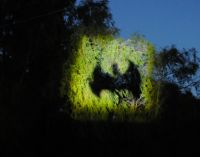

Tesladownunder, Thu Sept 30 2010, 09:25PM
Do you mean like this.
Always keen to take up a challenge at 5am when working day starts in a few hours...


Re: World's brightest flashlight
Tesladownunder, Sat Oct 02 2010, 06:22PM
I wonder if there are rules about shining lights at lighthouses?
This is my 100W LED run by some small SLA batteries.
Now imagine 15 of them with the same beam spread.
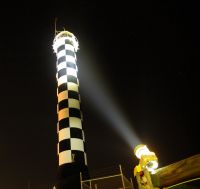
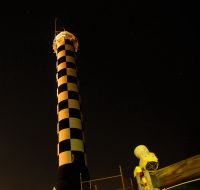
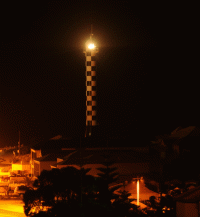
Tesladownunder, Sat Oct 02 2010, 06:22PM
Avi wrote ...
heaven forbid you point anything above 1mW upwards, in Australia...
Quite true, particularly as I am in an airport flight path.heaven forbid you point anything above 1mW upwards, in Australia...
I wonder if there are rules about shining lights at lighthouses?
This is my 100W LED run by some small SLA batteries.
Now imagine 15 of them with the same beam spread.



Re: World's brightest flashlight
teravolt, Sun Oct 03 2010, 03:02PM
if you used the collimator lenses you could probibly reach the light house from your picture on the bottom.
teravolt, Sun Oct 03 2010, 03:02PM
if you used the collimator lenses you could probibly reach the light house from your picture on the bottom.
Re: World's brightest flashlight
Adam Munich, Fri Oct 08 2010, 05:11AM
I found some 100W LEDs 40% cheaper.
Adam Munich, Fri Oct 08 2010, 05:11AM
I found some 100W LEDs 40% cheaper.

Re: World's brightest flashlight
Patrick, Fri Oct 08 2010, 06:15AM
I totally need to buy one of these, it woud be so useful for blinding russian fighter pilots at take off / landing. maybe better then a stinger missle, and its reusable...
Patrick, Fri Oct 08 2010, 06:15AM
I totally need to buy one of these, it woud be so useful for blinding russian fighter pilots at take off / landing. maybe better then a stinger missle, and its reusable...

Re: World's brightest flashlight
Tesladownunder, Sun Nov 07 2010, 10:47PM
After a lot of work on the bike I have returned to do some more on the flashlight. I now know how I will attach the barrel to the light source, so can go ahead with the internal frame.
At present only the red, blue, green and one of the 12 white LEDs are in action and no lenses yet. So "only" 400W (instead of 1500W).
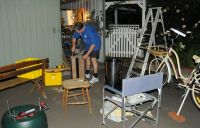

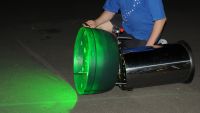
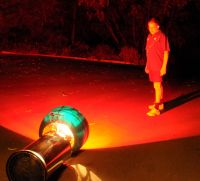
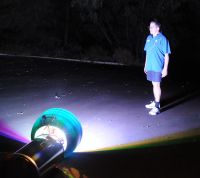
Tesladownunder, Sun Nov 07 2010, 10:47PM
After a lot of work on the bike I have returned to do some more on the flashlight. I now know how I will attach the barrel to the light source, so can go ahead with the internal frame.
At present only the red, blue, green and one of the 12 white LEDs are in action and no lenses yet. So "only" 400W (instead of 1500W).





Re: World's brightest flashlight
Thomas W, Mon Nov 08 2010, 07:39AM
Thats big
Realy big
how long does it run and does it need a power lead?
Thomas W, Mon Nov 08 2010, 07:39AM
Thats big
Realy big
how long does it run and does it need a power lead?
Re: World's brightest flashlight
Tesladownunder, Sat Nov 13 2010, 08:17PM
I now have the flashlight largely completed apart from populating the front array with 11 white LEDs. Total power at present is 400W which is just over 1/4 power.
It is heavy at 45kg and still has 5kg of lenses and fans to go.
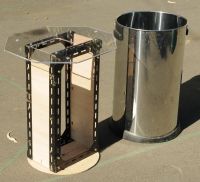
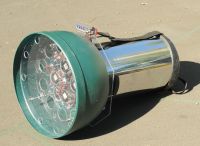

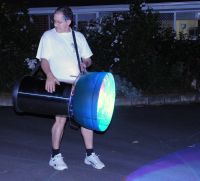

Tesladownunder, Sat Nov 13 2010, 08:17PM
I now have the flashlight largely completed apart from populating the front array with 11 white LEDs. Total power at present is 400W which is just over 1/4 power.
It is heavy at 45kg and still has 5kg of lenses and fans to go.





Re: World's brightest flashlight
Chris Russell, Sun Nov 14 2010, 09:55AM
Okay, just for fun, I did the math. Here's what I came up with. This may be a little messy; I'm mostly just copying and pasting from my notes.
I figured the easiest way to answer this question would be to consider how bright various things in space are on earth. This is called apparent visual magnitude. Happily, apparent visual magnitude can be converted to lux, or lumens per square meter, using the following formula:
So then, my reasoning goes as such:
So, if TDU were to shine his flashlight at the ISS as it passed overhead at night, observers on the ISS would see a point of light about as bright as Jupiter, at maximum brightness, appears here on Earth. That's pretty impressive, actually, and provided someone on the ISS were looking at the Earth at that moment, it would be very noticeable.
Note that 425km is actually the maximum altitude of the ISS. At its lowest, the altitude is 278km. If we are kinder, and use the median altitude of the ISS (352000m), the numbers are even better: 5.68e-5 lux, and -3.37 apparent visual magnitude. That is noticeably brighter than Jupiter, and approaching the minimum brightness of Venus.
And, just for fun, if TDU were to stand on a mountaintop and shine his flashlight at an observer far below, 10km away, on a clear night: 0.0701 lux, -11.1 apparent visual magnitude. That's brighter than a half-full moon, and given the beam profile, probably bright enough to start triggering alien abduction stories.
Chris Russell, Sun Nov 14 2010, 09:55AM
Tesladownunder wrote ...
Space = arbitrary 100 miles. Lets look at the reverse. A satellite can easily be seen against a black sky with dark adapted eyes - particularly the Iridium series. These will reflect light from the sun at 200W visible light per m2 from a 1 degree source. The reflecting surface will be say one square m from the satellite. ..... actually I am having trouble getting my head around the concept. Anyone want to have a go with those parameters?
Space = arbitrary 100 miles. Lets look at the reverse. A satellite can easily be seen against a black sky with dark adapted eyes - particularly the Iridium series. These will reflect light from the sun at 200W visible light per m2 from a 1 degree source. The reflecting surface will be say one square m from the satellite. ..... actually I am having trouble getting my head around the concept. Anyone want to have a go with those parameters?
Okay, just for fun, I did the math. Here's what I came up with. This may be a little messy; I'm mostly just copying and pasting from my notes.
I figured the easiest way to answer this question would be to consider how bright various things in space are on earth. This is called apparent visual magnitude. Happily, apparent visual magnitude can be converted to lux, or lumens per square meter, using the following formula:
Apparent magnitude: Negative numbers are brighter. Every five magnitudes is 100 fold increase in luminosity. An apparent magnitude of zero, on earth (ignoring atmosphere), is equal to 2.54e-6 lux.
Therefore, [2.54e-6 lux]/[100^(1/5)]^[Apparent Magnitude] = lux (lumens per square meter). Simpler: lux = 2.54e-6 / 2.512^a
Also works in reverse. a = -[log(50000000 * lux/127)]/log(314/125)
Proof we're not way off: -26.74, Sun's apparent visual magnitude, equals 131,000 lux. Direct sunlight is 26,000-130,000 lux depending on factors like altitude, angle, dust, etc. Looks good, since apparent magnitude is normalized to no atmosphere at all.
So then, my reasoning goes as such:
TDU's flashlight: 84,000 lumens
Half power beam width (2 * theta): 5 degrees (theta = 2.5 degrees)
ISS orbital altitude: 425000m
TDU flashlight half power beam width diameter at 425000m: 2 * tan(theta) * 425000 = 37100m
Total illuminated area (assume circle) = 1.08e9m^2
Total illuminance inside half-power area: (0.5 * 84000 lumens)/1.08e9 m^2 = 3.89-5 lux = -2.96 apparent visual magnitude
So, if TDU were to shine his flashlight at the ISS as it passed overhead at night, observers on the ISS would see a point of light about as bright as Jupiter, at maximum brightness, appears here on Earth. That's pretty impressive, actually, and provided someone on the ISS were looking at the Earth at that moment, it would be very noticeable.
Note that 425km is actually the maximum altitude of the ISS. At its lowest, the altitude is 278km. If we are kinder, and use the median altitude of the ISS (352000m), the numbers are even better: 5.68e-5 lux, and -3.37 apparent visual magnitude. That is noticeably brighter than Jupiter, and approaching the minimum brightness of Venus.
And, just for fun, if TDU were to stand on a mountaintop and shine his flashlight at an observer far below, 10km away, on a clear night: 0.0701 lux, -11.1 apparent visual magnitude. That's brighter than a half-full moon, and given the beam profile, probably bright enough to start triggering alien abduction stories.

Re: World's brightest flashlight
Tesladownunder, Sun Nov 14 2010, 07:13PM
That is all fascinating and brighter than thought. I am a bit surprised that any light would be visible over a 37km beam spot. Thanks for that calculation, I am sure I will quote it frequently.
I just received a light meter I bought on eBay, covering 5 decades up to 400kLux. Sunlight reads about 100kLux early in the morning and my previous single white LED is 200kLux at the lens at 10cm. I probably need to work things out a bit further out when the beam is defined at 5 degrees.
I am preparing a big white cloth backdrop (3x4m) to shine the beam against to compare with other light sources such as car headlights that have a different beam dispersion. I have the frame and the wife has done the sewing. Also a good black backdrop for general photos.
One thing that I would like to do is audio modulate the beam and hook a receiving solar panel to a speaker. That would be cool. This can't be done with full modulation with any other light source really. I could communicate with the ISS covertly.
I have only two LED's to go in the array to be fully populated so hopefully more results soon.
Tesladownunder, Sun Nov 14 2010, 07:13PM
Chris Russell wrote ...
Okay, just for fun, I did the math. .... So, if TDU were to shine his flashlight at the ISS as it passed overhead at night, observers on the ISS would see a point of light about as bright as Jupiter, at maximum brightness, appears here on Earth. That's pretty impressive, actually, and provided someone on the ISS were looking at the Earth at that moment, it would be very noticeable.
Okay, just for fun, I did the math. .... So, if TDU were to shine his flashlight at the ISS as it passed overhead at night, observers on the ISS would see a point of light about as bright as Jupiter, at maximum brightness, appears here on Earth. That's pretty impressive, actually, and provided someone on the ISS were looking at the Earth at that moment, it would be very noticeable.
That is all fascinating and brighter than thought. I am a bit surprised that any light would be visible over a 37km beam spot. Thanks for that calculation, I am sure I will quote it frequently.
I just received a light meter I bought on eBay, covering 5 decades up to 400kLux. Sunlight reads about 100kLux early in the morning and my previous single white LED is 200kLux at the lens at 10cm. I probably need to work things out a bit further out when the beam is defined at 5 degrees.
I am preparing a big white cloth backdrop (3x4m) to shine the beam against to compare with other light sources such as car headlights that have a different beam dispersion. I have the frame and the wife has done the sewing. Also a good black backdrop for general photos.
One thing that I would like to do is audio modulate the beam and hook a receiving solar panel to a speaker. That would be cool. This can't be done with full modulation with any other light source really. I could communicate with the ISS covertly.
I have only two LED's to go in the array to be fully populated so hopefully more results soon.
Re: World's brightest flashlight
Chris Russell, Mon Nov 15 2010, 08:45AM
Thanks. I should note that Jupiter is near maximum brightness now (-2.5), and it is fairly impressive to look at, even when it's close to the moon and seen from a light-polluted city like mine. From space, at night, against the backdrop of a relatively dark Earth, I'd imagine the flashlight would be quite hard to miss. Anyone know someone on board the ISS?
Of course, the calculation assumes that power is distributed equally along the entire 5 degrees. Some measurements of the beam at an intermediate distance of some meters could probably help create a more refined calculation.
Full modulation would be amazing. I've seen LEDs and photodetectors communicate over distances of miles just using atmospheric scattering; both were simply pointed straight up rather than at one another. With a good photodetector and lens, and the flashlight aimed at the horizon, I wouldn't be too surprised if communication were possible over 100km+ distances in darker areas.
Chris Russell, Mon Nov 15 2010, 08:45AM
Tesladownunder wrote ...
That is all fascinating and brighter than thought. I am a bit surprised that any light would be visible over a 37km beam spot. Thanks for that calculation, I am sure I will quote it frequently.
I just received a light meter I bought on eBay, covering 5 decades up to 400kLux. Sunlight reads about 100kLux early in the morning and my previous single white LED is 200kLux at the lens at 10cm. I probably need to work things out a bit further out when the beam is defined at 5 degrees.
That is all fascinating and brighter than thought. I am a bit surprised that any light would be visible over a 37km beam spot. Thanks for that calculation, I am sure I will quote it frequently.
I just received a light meter I bought on eBay, covering 5 decades up to 400kLux. Sunlight reads about 100kLux early in the morning and my previous single white LED is 200kLux at the lens at 10cm. I probably need to work things out a bit further out when the beam is defined at 5 degrees.
Thanks. I should note that Jupiter is near maximum brightness now (-2.5), and it is fairly impressive to look at, even when it's close to the moon and seen from a light-polluted city like mine. From space, at night, against the backdrop of a relatively dark Earth, I'd imagine the flashlight would be quite hard to miss. Anyone know someone on board the ISS?
Of course, the calculation assumes that power is distributed equally along the entire 5 degrees. Some measurements of the beam at an intermediate distance of some meters could probably help create a more refined calculation.
Full modulation would be amazing. I've seen LEDs and photodetectors communicate over distances of miles just using atmospheric scattering; both were simply pointed straight up rather than at one another. With a good photodetector and lens, and the flashlight aimed at the horizon, I wouldn't be too surprised if communication were possible over 100km+ distances in darker areas.
Re: World's brightest flashlight
Tesladownunder, Tue Nov 16 2010, 02:54PM
The beam is actually a square and you can make out the individual elements and even the bonding wires if the optics are good. With multiple LEDs all at an angle, the net result should be circular and reasonably uniform.
I have now populated the array. It is a real rats nest of point to point cabling for wires carring 100mA up to 60A. Remember each LED is buffered with a 6v 3A auto globe although the only one that lights up here is the Red LED that has to drop much more voltage, hence uses both filaments of a globe plus a resistor. The globes are a non linear resistance that allow current sharing, current limiting under diffferent loads and also are a fuse with less thermal inertia than the LED.
Power here is 11A at 31V = 320W which is around 20% of capacity.

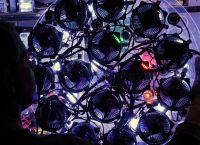
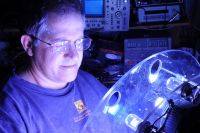
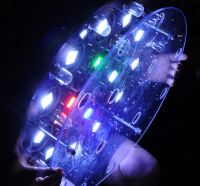
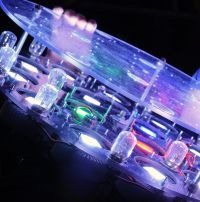
Tesladownunder, Tue Nov 16 2010, 02:54PM
The beam is actually a square and you can make out the individual elements and even the bonding wires if the optics are good. With multiple LEDs all at an angle, the net result should be circular and reasonably uniform.
I have now populated the array. It is a real rats nest of point to point cabling for wires carring 100mA up to 60A. Remember each LED is buffered with a 6v 3A auto globe although the only one that lights up here is the Red LED that has to drop much more voltage, hence uses both filaments of a globe plus a resistor. The globes are a non linear resistance that allow current sharing, current limiting under diffferent loads and also are a fuse with less thermal inertia than the LED.
Power here is 11A at 31V = 320W which is around 20% of capacity.





Re: World's brightest flashlight
Adam Munich, Tue Nov 16 2010, 09:24PM
Did you find any more hidden numbers in the LEDs?
Adam Munich, Tue Nov 16 2010, 09:24PM
Did you find any more hidden numbers in the LEDs?
Re: World's brightest flashlight
Tesladownunder, Mon Nov 22 2010, 12:39AM
And is it bright? You bet. Vastly brighter than anything I have access to. The beam is a flat uniform and surprisingly well demarcated disc of light of approximately 5 degrees. There is a lot of light spill outside or a degree or two away from the focal beam giving a surrounding umbra.
On full power (front array only for the Flashlight) voltage is 36.8v and 43.7A ie 1600W in of which about 1300W gets to the LEDs and the rest goes to ballast lamps and fans. Add another 300W for the bike with the rear lights although the voltage drop will reduce that but looking at about 1800W.
Here are some lenses and the completion on the front array. And a low power shot with blue and red LEDs on.
Also shows the trolley setup as I don't like lugging 50+kg more than a few steps. But it is still portable... I have made the trolley adjustable and able to be placed at any angle from vertical to horizontal.

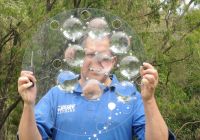

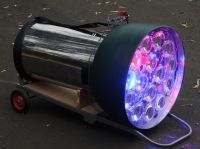
Tesladownunder, Mon Nov 22 2010, 12:39AM
Grenadier wrote ...
Did you find any more hidden numbers in the LEDs?
That was just a quirk of the threshhold and active surface configuration. No more hidden messages.Did you find any more hidden numbers in the LEDs?
And is it bright? You bet. Vastly brighter than anything I have access to. The beam is a flat uniform and surprisingly well demarcated disc of light of approximately 5 degrees. There is a lot of light spill outside or a degree or two away from the focal beam giving a surrounding umbra.
On full power (front array only for the Flashlight) voltage is 36.8v and 43.7A ie 1600W in of which about 1300W gets to the LEDs and the rest goes to ballast lamps and fans. Add another 300W for the bike with the rear lights although the voltage drop will reduce that but looking at about 1800W.
Here are some lenses and the completion on the front array. And a low power shot with blue and red LEDs on.
Also shows the trolley setup as I don't like lugging 50+kg more than a few steps. But it is still portable... I have made the trolley adjustable and able to be placed at any angle from vertical to horizontal.




Re: World's brightest flashlight
Chris Russell, Mon Nov 22 2010, 01:40AM
Time to get in touch with someone on the ISS!
Excellent work, can't wait to see more.
Chris Russell, Mon Nov 22 2010, 01:40AM
Time to get in touch with someone on the ISS!
Excellent work, can't wait to see more.
Re: World's brightest flashlight
klugesmith, Mon Nov 22 2010, 02:33AM
TDU: with your luxmeter you can determine the candlepower.
Simply measure the lux at distance of say 100 meters (so you're properly in the far field)
and multiply by 100^2.
Re. ISS visibility: I figured numbers similar to Chris's.
I honestly don't want to rain on anyone's parade, but the candlepower aren't that spectacular
because, as TDU says, the LEDs are a diffuse source & hard to focus into a narrow beam.
Half of 84000 lm in a 5-degree-wide beam (0.006 steradians) is about 7 million candlepower.
Companies like to advertise handheld spotlights with higher cd ratings (probably a stretch)
that put out fewer lumens, but tune the optics to make the narrowest possible spot.
Ordinary green laser pointers have comparable candlepower (single digit lumens in sub-milliradian beam).
Trailer-mounted searchlights are in a different class -- you could rent an honest 120 Mcd unit to advertise your event, or summon Batman. Real IMAX projectors (not the lame digital IMAX in shopping mall cineplexes) have a 600000 lumen lamp with source area less than 1 cm^2.
The instant on/off modulation capability makes TDU's LED flashlight uniquely good for, say, signaling to an observer at (or from) a distant mountain. Maybe even in the daytime -- you can aim close enough without needing to see the beam. In the great war, on/off modulation was done with mechanical shutters like Venetian blinds. Please keep us on the news list!
-Rich
klugesmith, Mon Nov 22 2010, 02:33AM
TDU: with your luxmeter you can determine the candlepower.
Simply measure the lux at distance of say 100 meters (so you're properly in the far field)
and multiply by 100^2.
Re. ISS visibility: I figured numbers similar to Chris's.
I honestly don't want to rain on anyone's parade, but the candlepower aren't that spectacular
because, as TDU says, the LEDs are a diffuse source & hard to focus into a narrow beam.
Half of 84000 lm in a 5-degree-wide beam (0.006 steradians) is about 7 million candlepower.
Companies like to advertise handheld spotlights with higher cd ratings (probably a stretch)
that put out fewer lumens, but tune the optics to make the narrowest possible spot.
Ordinary green laser pointers have comparable candlepower (single digit lumens in sub-milliradian beam).
Trailer-mounted searchlights are in a different class -- you could rent an honest 120 Mcd unit to advertise your event, or summon Batman. Real IMAX projectors (not the lame digital IMAX in shopping mall cineplexes) have a 600000 lumen lamp with source area less than 1 cm^2.
The instant on/off modulation capability makes TDU's LED flashlight uniquely good for, say, signaling to an observer at (or from) a distant mountain. Maybe even in the daytime -- you can aim close enough without needing to see the beam. In the great war, on/off modulation was done with mechanical shutters like Venetian blinds. Please keep us on the news list!
-Rich
Re: World's brightest flashlight
Tesladownunder, Mon Dec 06 2010, 01:19PM
I would need to servo my flashlight with a small telescope that can be set at least every 5-10 seconds to allow coverage of the invisible ISS position in the 5 degree beam.
Testing a single focussed 100W LED at 25m the meter gave 36 lux. So by your formula candle power is 36*25*25=22,500. Multiplying this by the 15 LEDs gives 337,500. Of course, I need to measure the array directly, but it is a long way from 7 million which I would associate perhaps with a highly focussed HID light. I need to get my head around all these photonic terms.
I have done the video shoot with interviews, overlays and details of the bike, flashlight and Xmas tree with Santa riding the bike. It will be the colors rather than the maximum power that will be the best TV feature of this bike.
Still need to get a good "money shot" still which is tricky with 4 light sources to get right.
Also need to finish off some video of comparative flashlight shots then it's finished.
Here are some data though. Switch on current for one LED is about 7A decaying over 200ms to 3.4A as the ballast filament heats up. Switch on light output (measured by silicon cell) is only up 5% however, so it seems that they are being driven reasonably fully at least individually with full battery charge. Actually I have just realised that was for switching the full array on so the data are not really comparable. I need to recheck this properly.

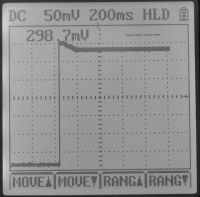
Tesladownunder, Mon Dec 06 2010, 01:19PM
Chris Russell wrote ...
Time to get in touch with someone on the ISS!
I hope to contact Andy Thomas (Aussie NASA astronaut) sometime once I have a solid proposal for the ISS team to look out from their new cupola.Time to get in touch with someone on the ISS!
I would need to servo my flashlight with a small telescope that can be set at least every 5-10 seconds to allow coverage of the invisible ISS position in the 5 degree beam.
Klugesmith wrote ...
TDU: with your luxmeter you can determine the candlepower.
Simply measure the lux at distance of say 100 meters (so you're properly in the far field)
and multiply by 100^2.
Re. ISS visibility: I figured numbers similar to Chris's.
I honestly don't want to rain on anyone's parade, but the candlepower aren't that spectacular
because, as TDU says, the LEDs are a diffuse source & hard to focus into a narrow beam.
Half of 84000 lm in a 5-degree-wide beam (0.006 steradians) is about 7 million candlepower.
The instant on/off modulation capability makes TDU's LED flashlight uniquely good for, say, signaling to an observer at (or from) a distant mountain. ....
I need to get the data from farfield. I have some nearfield readings but they are not really meaningful. At each lens the reading is about 200klx (sunlight 130klx).TDU: with your luxmeter you can determine the candlepower.
Simply measure the lux at distance of say 100 meters (so you're properly in the far field)
and multiply by 100^2.
Re. ISS visibility: I figured numbers similar to Chris's.
I honestly don't want to rain on anyone's parade, but the candlepower aren't that spectacular
because, as TDU says, the LEDs are a diffuse source & hard to focus into a narrow beam.
Half of 84000 lm in a 5-degree-wide beam (0.006 steradians) is about 7 million candlepower.
The instant on/off modulation capability makes TDU's LED flashlight uniquely good for, say, signaling to an observer at (or from) a distant mountain. ....
Testing a single focussed 100W LED at 25m the meter gave 36 lux. So by your formula candle power is 36*25*25=22,500. Multiplying this by the 15 LEDs gives 337,500. Of course, I need to measure the array directly, but it is a long way from 7 million which I would associate perhaps with a highly focussed HID light. I need to get my head around all these photonic terms.
I have done the video shoot with interviews, overlays and details of the bike, flashlight and Xmas tree with Santa riding the bike. It will be the colors rather than the maximum power that will be the best TV feature of this bike.
Still need to get a good "money shot" still which is tricky with 4 light sources to get right.
Also need to finish off some video of comparative flashlight shots then it's finished.
Here are some data though. Switch on current for one LED is about 7A decaying over 200ms to 3.4A as the ballast filament heats up. Switch on light output (measured by silicon cell) is only up 5% however, so it seems that they are being driven reasonably fully at least individually with full battery charge. Actually I have just realised that was for switching the full array on so the data are not really comparable. I need to recheck this properly.


Re: World's brightest flashlight
Chris Russell, Tue Dec 07 2010, 09:40AM
That would be a really awesome experiment. Many of the astronauts on board will be familiar with Morse code. Perhaps you could relay a brief message to the station using either on/off modulation, or visual FSK (only red, blue, or green on = off, everything on = on). Fortunately, with a five degree wide beam, aiming doesn't need to be too precise.
I don't know if a telescope would be necessary. Amateur radio operators make use of keplerian elements to aim their antennas at orbiting satellites (and the ISS) during passes, which works well even for antennas with a beamwidth similar to your flashlight. A properly calibrated gimbal with markers for elevation and azimuth could allow the flashlight to be rotated through the path of the pass manually. Of course, there are two-axis rotors, but getting one to work with your flashlight might be... problematic.
Chris Russell, Tue Dec 07 2010, 09:40AM
Tesladownunder wrote ...
I hope to contact Andy Roberts (Aussie NASA astronaut) sometime once I have a solid proposal for the ISS team to look out from their new cupola.
I would need to servo my flashlight with a small telescope that can be set at least every 5-10 seconds to allow coverage of the invisible ISS position in the 5 degree beam.
I hope to contact Andy Roberts (Aussie NASA astronaut) sometime once I have a solid proposal for the ISS team to look out from their new cupola.
I would need to servo my flashlight with a small telescope that can be set at least every 5-10 seconds to allow coverage of the invisible ISS position in the 5 degree beam.
That would be a really awesome experiment. Many of the astronauts on board will be familiar with Morse code. Perhaps you could relay a brief message to the station using either on/off modulation, or visual FSK (only red, blue, or green on = off, everything on = on). Fortunately, with a five degree wide beam, aiming doesn't need to be too precise.
I don't know if a telescope would be necessary. Amateur radio operators make use of keplerian elements to aim their antennas at orbiting satellites (and the ISS) during passes, which works well even for antennas with a beamwidth similar to your flashlight. A properly calibrated gimbal with markers for elevation and azimuth could allow the flashlight to be rotated through the path of the pass manually. Of course, there are two-axis rotors, but getting one to work with your flashlight might be... problematic.
Re: World's brightest flashlight
Tesladownunder, Sat Dec 11 2010, 05:13AM
This is my first distance shot. 2.5km along the straight stretch of Lillydale Rd out of Bunbury.
Photo 1 shows the 1/4 moon for brightness reference and a car heading down that stretch about 100m away. My son's car taillights are in the foreground.
Photo 2 shows the Flashlight firing the white LED's 1200W from 2.5km. The moon has moved to be a bit obscured by trees (long wait for a car free period).
Photo 1 shows the green light alone to confirm the source.
I believe Chris' calculations about 1/2 moon brightness at 10km now. It just didn't seem intuitively right before.
Now I want to try Bunbury to Busselton (up to 45k) but I will need to get a vantage point either end to allow it to get over earth curvature (3.6m drop). This pic of the comet shows a 35 km view to Busselton (horizon lights on left) to Cape Naturaliste lighthouse on right.
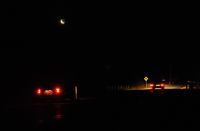

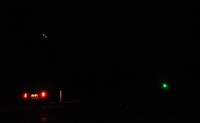
Tesladownunder, Sat Dec 11 2010, 05:13AM
This is my first distance shot. 2.5km along the straight stretch of Lillydale Rd out of Bunbury.
Photo 1 shows the 1/4 moon for brightness reference and a car heading down that stretch about 100m away. My son's car taillights are in the foreground.
Photo 2 shows the Flashlight firing the white LED's 1200W from 2.5km. The moon has moved to be a bit obscured by trees (long wait for a car free period).
Photo 1 shows the green light alone to confirm the source.
I believe Chris' calculations about 1/2 moon brightness at 10km now. It just didn't seem intuitively right before.
Now I want to try Bunbury to Busselton (up to 45k) but I will need to get a vantage point either end to allow it to get over earth curvature (3.6m drop). This pic of the comet shows a 35 km view to Busselton (horizon lights on left) to Cape Naturaliste lighthouse on right.



Re: World's brightest flashlight
Tesladownunder, Mon Jan 10 2011, 06:33PM
I have received a response from NASA who have forwarded my proposal to the operations team. It's just a foot in the door but is a first step. Fingers crossed from here.
My proposal has been fine tuned significantly since I last wrote and is in detail here on my site.
In essence one plan is to go to a place where there is a 90 degree pass over by the ISS at night. Set up the static flashlight vertically. Brightness based on measured lux values is about that of Canopus, (Apparent magnitude -0.72). Flash a Morse coded message in the 2.5 second flyover with the ISS using their 400mm Nikon D3 with open shutter and not tracked. The Morse code can be read out on the film which provides proof of sighting for Guinness.
There is 8 seconds of visual view time on the ISS with a static flashlight.
Plan B is to have the flashlight track the ISS to get longer visual view times (perhaps 1 minute).
My proposal was:
Subject: Potential publicity photo for ISS. Request night photos of Western AustraliaI have a proposal that may be easy for the ISS to perform and give a nice TV news segment. Also perhaps world firsts such as seeing a flashlight from space or reading Morse code from space.
It is a positive article easily understood by the public and takes only minutes of ISS astronaut time.
I have made the World's most powerful flashlight at around 84,000 lumens nominal. (Guinness Record applied for)
With a 10 degree beam (around 32,000 lumens) this will be visible at ISS altitude as apparent magnitude –0.7 at 230 miles altitude which is the brightness of Canopus, the second brightest star.
The thing about this light is that it is bright and being LED rather than incandescent or discharge can be modulated into a morse code, or even an audio signal.
Accordingly a night time ISS pass in astronaut waking hours over South Western Australia in the next 3 summer months (generally cloudless and low population density) would see this.
A long camera exposure (NO tracking required) would therefore present a string of "dots and dashes" on the picture whereas all other lights will be streaks. It should be a striking picture from which Morse code could be read.
I would not need to track the ISS once set up for a single photo still, but would with an accuracy of 5 degrees if it was to be viewed directly by an astronaut as well (preferable).
If this proposal is of interest I can present more solid data, mechanical tracking information, Guinness information and plans for optimal siting for dates and times. In particular aiming for a near 90 degree elevation.
I am an Australian experimenter with a high media profile (eg on Discovery Channel 5 times) and have the resources to make this a success from my end.
My relevant web page and proposal is here:
This shows the relative positions of the ISS (using the Nikon D3 400mm lens) and the Flashlight.
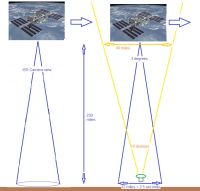
This shows a simulated view from the ISS camera with open shutter for 2.5 seconds showing my flashlight
modulated light amongst the other town/city lights. This will be morse coded to give a brief message.
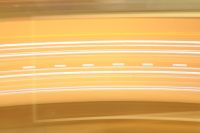
This is the flashlight viewed from 9km.
The ISS view at 230 miles will be less by a factor of 1700 but still very visible at night to the naked eye.
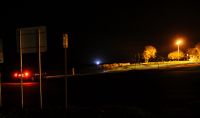
NASA's response:Thank you for your message. I have forwarded on your request to our operations team for review. Acquisition of specific target imagery from the ISS is dependent on several factors including the crew task schedule, orbital position of the spacecraft, and environmental factors (cloud cover in this case).
The crew does sometimes take imagery of areas outside their standing science targets, and I recommend that you periodically check our online database for night time imagery of the western Australia coastline to see if the Bunbury region has been acquired. You may use our technical search tools at for this purpose, I would recommend doing a combined Geographic Region and Features search (use the keyword “night†– no quotes required).
for this purpose, I would recommend doing a combined Geographic Region and Features search (use the keyword “night†– no quotes required).
We also have an Uncataloged image search tool at - crew discretionary images as described above are typically not high priority for cataloging, so you are most likely to find new imagery using this tool.
- crew discretionary images as described above are typically not high priority for cataloging, so you are most likely to find new imagery using this tool.
Thank you for your interest in astronaut photography of Earth!
Earthweb
The Gateway to Astronaut Photography of Earth
NASA Johnson Space Center

Tesladownunder, Mon Jan 10 2011, 06:33PM
I have received a response from NASA who have forwarded my proposal to the operations team. It's just a foot in the door but is a first step. Fingers crossed from here.
My proposal has been fine tuned significantly since I last wrote and is in detail here on my site.
In essence one plan is to go to a place where there is a 90 degree pass over by the ISS at night. Set up the static flashlight vertically. Brightness based on measured lux values is about that of Canopus, (Apparent magnitude -0.72). Flash a Morse coded message in the 2.5 second flyover with the ISS using their 400mm Nikon D3 with open shutter and not tracked. The Morse code can be read out on the film which provides proof of sighting for Guinness.
There is 8 seconds of visual view time on the ISS with a static flashlight.
Plan B is to have the flashlight track the ISS to get longer visual view times (perhaps 1 minute).
My proposal was:
Subject: Potential publicity photo for ISS. Request night photos of Western AustraliaI have a proposal that may be easy for the ISS to perform and give a nice TV news segment. Also perhaps world firsts such as seeing a flashlight from space or reading Morse code from space.
It is a positive article easily understood by the public and takes only minutes of ISS astronaut time.
I have made the World's most powerful flashlight at around 84,000 lumens nominal. (Guinness Record applied for)
With a 10 degree beam (around 32,000 lumens) this will be visible at ISS altitude as apparent magnitude –0.7 at 230 miles altitude which is the brightness of Canopus, the second brightest star.
The thing about this light is that it is bright and being LED rather than incandescent or discharge can be modulated into a morse code, or even an audio signal.
Accordingly a night time ISS pass in astronaut waking hours over South Western Australia in the next 3 summer months (generally cloudless and low population density) would see this.
A long camera exposure (NO tracking required) would therefore present a string of "dots and dashes" on the picture whereas all other lights will be streaks. It should be a striking picture from which Morse code could be read.
I would not need to track the ISS once set up for a single photo still, but would with an accuracy of 5 degrees if it was to be viewed directly by an astronaut as well (preferable).
If this proposal is of interest I can present more solid data, mechanical tracking information, Guinness information and plans for optimal siting for dates and times. In particular aiming for a near 90 degree elevation.
I am an Australian experimenter with a high media profile (eg on Discovery Channel 5 times) and have the resources to make this a success from my end.
My relevant web page and proposal is here:

This shows the relative positions of the ISS (using the Nikon D3 400mm lens) and the Flashlight.

This shows a simulated view from the ISS camera with open shutter for 2.5 seconds showing my flashlight
modulated light amongst the other town/city lights. This will be morse coded to give a brief message.

This is the flashlight viewed from 9km.
The ISS view at 230 miles will be less by a factor of 1700 but still very visible at night to the naked eye.

NASA's response:Thank you for your message. I have forwarded on your request to our operations team for review. Acquisition of specific target imagery from the ISS is dependent on several factors including the crew task schedule, orbital position of the spacecraft, and environmental factors (cloud cover in this case).
The crew does sometimes take imagery of areas outside their standing science targets, and I recommend that you periodically check our online database for night time imagery of the western Australia coastline to see if the Bunbury region has been acquired. You may use our technical search tools at
 for this purpose, I would recommend doing a combined Geographic Region and Features search (use the keyword “night†– no quotes required).
for this purpose, I would recommend doing a combined Geographic Region and Features search (use the keyword “night†– no quotes required).We also have an Uncataloged image search tool at
 - crew discretionary images as described above are typically not high priority for cataloging, so you are most likely to find new imagery using this tool.
- crew discretionary images as described above are typically not high priority for cataloging, so you are most likely to find new imagery using this tool.Thank you for your interest in astronaut photography of Earth!
Earthweb
The Gateway to Astronaut Photography of Earth
NASA Johnson Space Center

Re: World's brightest flashlight
Chris Russell, Mon Jan 10 2011, 08:19PM
Looks like kind of a canned response to a "take a picture of my house please" type of request, but it's good to have a foot in the door. Hopefully the next person up the chain will take a closer look at your proposal.
The 2.5km picture is amazing.
Chris Russell, Mon Jan 10 2011, 08:19PM
Looks like kind of a canned response to a "take a picture of my house please" type of request, but it's good to have a foot in the door. Hopefully the next person up the chain will take a closer look at your proposal.
The 2.5km picture is amazing.
Print this page